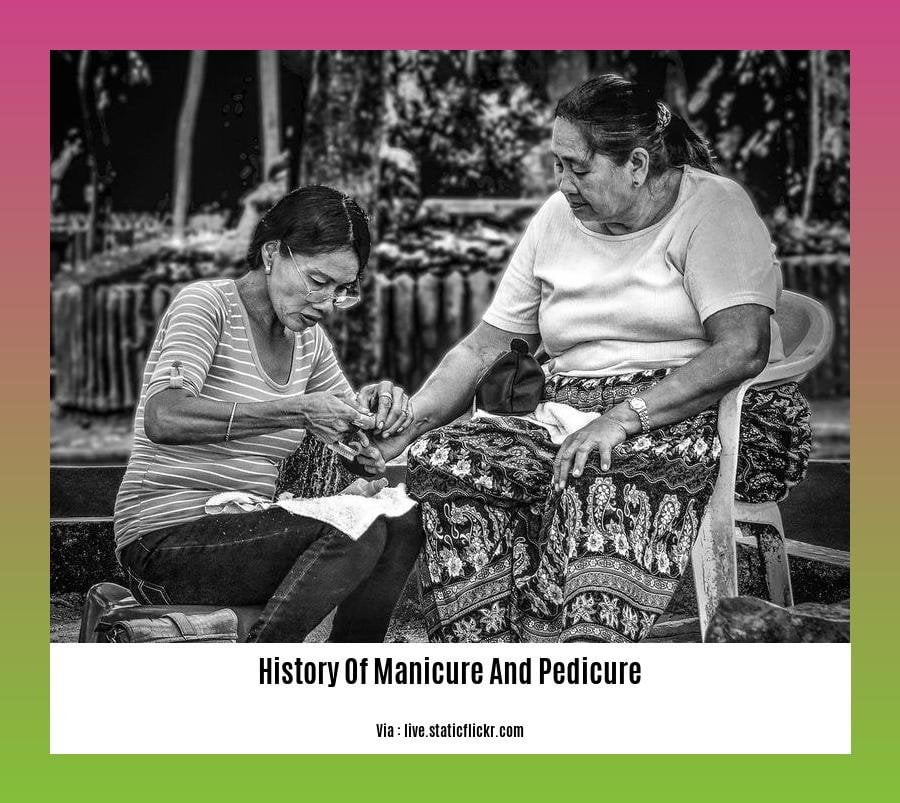Embark on a fascinating journey through time as we delve into the rich history of manicures and pedicures in [A Journey Through Time: Exploring the Rich History of Manicure and Pedicure]. From ancient rituals to modern-day beauty essentials, discover the captivating tales of opulence, innovation, and cultural significance that have shaped the world of nail care.
Key Takeaways:
- Manicures and pedicures are ancient practices, dating back to civilizations in Egypt, China, and India.
- The term “manicure” comes from the French word meaning “care of the hands,” and “pedicure” derives from Latin words meaning “foot care.”
- The first professional manicurist opened a salon in Paris in 1892, pioneering modern manicure and pedicure practices.
- Egyptians highly valued foot and leg care, using red nail color to signify high social status.
History of Manicure and Pedicure

Originating in ancient civilizations, manicures and pedicures have traversed time, evolving into essential beauty practices.
In ancient Egypt, manicures and pedicures were reserved for royalty and wealthy individuals. They used henna to color their nails, which symbolized high social status.
The Romans and Greeks also embraced nail care, using beeswax and olive oil to moisturize their nails.
In the 19th century, the French popularized the modern manicure when a Parisian nail salon owner, Madame Marie E. Lefebvre, introduced the practice of manicures to the world.
The 20th century brought about significant advancements in nail care, with the introduction of artificial nails, gel polish, and various nail art techniques.
Today, manicures and pedicures are enjoyed by people of all ages and backgrounds, symbolizing self-care, beauty, and personal expression.
-
Delve into the captivating history of the magazine industry in India, tracing its evolution from its humble beginnings to its current status as a powerful medium of information and entertainment. history of magazines in india
-
Uncover the rich cultural heritage of the Philippines through the enchanting Maglalatik folk dance, a vibrant display of grace, agility, and storytelling that pays homage to the country’s coconut-farming traditions. history of maglalatik folk dance
-
Embark on a fascinating journey through the ages, exploring the intriguing history of manicure, from its humble origins as a grooming ritual to its transformation into an essential part of modern beauty routines. history of manicure
-
Dive deep into the dynamic evolution of marketing, tracing its roots from ancient barter systems to the sophisticated strategies and technologies that shape modern business practices. history of marketing ss1
Cultural Symbolism: Delve into the cultural significance of manicures and pedicures, examining how they have been used to convey social status, personal style, and societal norms across different cultures.
Cultural norms and societal positions have long held significance for manicures and pedicures. These treatments have been imbued with deep implications. Let’s travel across civilizations, uncovering how these nail care practices have served as symbols and mirrors of cultural values.
A Journey Across Cultures
Our adventure starts with the ancients. In Egypt, manicures and pedicures were reserved for the privileged few, signifying high social status. Egyptians revered beauty, and these practices were symbols of that regard. Similarly, China’s Dowager Empress Cixi flaunted beautifully long nails, showcasing her status and power.
In India, the cultural significance of nail care dates back millennia, with intricate henna designs gracing women’s nails. Henna, an integral part of their culture, symbolized not only beauty but also auspiciousness and joy. In the 19th century, Europe found its fascination with long, pointed nails and elaborate nail art, a trend popularized by royalty and the elite.
The Modern Context
The 20th century brought about a revolution in the nail industry, with the invention of synthetic materials like acrylics and gels. These materials fostered longer-lasting and dazzling manicures, no longer limited to the affluent. In the present day, these practices are accessible to everyone.
Today, manicures and pedicures are widely embraced as integral components of self-care and beauty routines. In fact, they’ve become a canvas for creativity and personal expression. Nail art has evolved as a medium for storytelling, with a vast array of designs, embellishments, and techniques.
Beyond Beautification
Beyond aesthetic allure, manicures and pedicures hold deeper cultural significance. For many, they represent a form of self-expression. Nail art is an avenue for creativity, allowing individuals to showcase their style and personality. For others, these treatments symbolize personal grooming and taking pride in one’s appearance.
**Key Takeaways:
- In ancient Egypt, manicures and pedicures were symbols of high social status and beauty.
- China’s Dowager Empress Cixi’s long, beautiful nails symbolized her power and status.
- In India, henna designs on nails represented auspiciousness, joy, and beauty.
- In the 19th century, Europe’s elite and royalty popularized long, pointed nails and elaborate nail art.
- The 20th century’s invention of acrylics and gels revolutionized the nail industry, making it accessible to everyone.
- Today, manicures and pedicures are widely embraced as a form of self-care, beauty, and personal expression.
[Bibliography]
[1] Louisville Beauty Academy: https://louisvillebeautyacademy.net/the-history-of-manicure-and-pedicure/
[2] Leaf.tv:
East Meets West: Compare the Contrasting Nail Care Traditions of the East and the West

Delving into the captivating world of nail care, we embark on a journey to explore the intriguing contrasts between Eastern and Western nail care traditions. These distinct approaches have been shaped by unique philosophies, techniques, and beauty ideals, offering a fascinating insight into the diverse cultural influences that have shaped this essential aspect of personal grooming.
Across Eastern and Western cultures, manicures and pedicures have held significant cultural and historical significance. In the East, nail care was intricately tied to spiritual beliefs and social status. The Dowager Empress Cixi of China, for instance, was renowned for her exquisitely long nails, symbolizing her power and authority. In contrast, Western cultures have historically viewed nail care as a symbol of beauty, cleanliness, and personal expression.
Techniques and Philosophies
Eastern nail care traditions often emphasize natural beauty and holistic well-being. Practitioners focus on promoting nail health and vitality through gentle techniques and natural remedies. Acupressure and reflexology are commonly incorporated to stimulate circulation, improve overall health, and balance the body’s energy flow.
In contrast, Western nail care techniques tend to be more focused on aesthetics and durability. Artificial nails, gel polishes, and intricate nail art designs are widely used to create a variety of looks, catering to diverse personal styles and preferences.
Beauty Ideals
Eastern cultures often embrace a minimalist approach to nail care, with a focus on natural, understated elegance. Nudes, soft pinks, and neutral shades are commonly favored, complementing the natural beauty of the nails.
Western beauty ideals, on the other hand, tend to favor bolder, more expressive nail designs. Bright colors, intricate patterns, and embellishments are often used to create eye-catching looks that reflect individual style and creativity.
Key Takeaways:
-
Eastern nail care traditions emphasize natural beauty, holistic well-being, and gentle techniques, while Western approaches focus on aesthetics, durability, and personal expression.
-
Eastern cultures often prefer natural, understated nail designs, while Western cultures embrace bolder, more expressive looks.
-
Both Eastern and Western nail care traditions have evolved over time, incorporating new techniques and trends to meet the ever-changing needs and preferences of consumers.
-
Despite their differences, both Eastern and Western nail care traditions share a common goal: to enhance the beauty and well-being of individuals, promoting self-care and personal expression through the art of nail care.
Sources
-
East Meets West: An Exploration and Analysis of Eastern and Western Cultures
-
Cultural Differences between Western and Eastern Education
Modern Trends and Innovations: Showcase the latest trends and innovations in the world of manicures and pedicures, including gel polishes, nail art, and advancements in nail health and wellness.
We’ve come a long way from henna nails in ancient times! The world of nail care has evolved dramatically, embracing innovative techniques, products, and trends that elevate the art of manicures and pedicures. Let’s take a closer look at the exciting world of modern nail care.
Gel Polishes: A Game-Changer
Gel polishes have revolutionized the industry with their long-lasting shine and durability. These polishes are applied like traditional polish but cured under a UV or LED lamp, resulting in a chip-resistant, glossy finish that can last up to two weeks. Say goodbye to daily touch-ups and hello to hassle-free, vibrant nails.
Nail Art: Unleash Your Creativity
Nail art has become a canvas for self-expression, showcasing intricate designs, embellishments, and 3D elements. From geometric patterns and glitter accents to hand-painted masterpieces, there’s no limit to the artistic possibilities. Express your unique style with a design that speaks to your personality.
Advancements in Nail Health and Wellness
The focus on nail health has taken center stage. Strengthening treatments, cuticle oils, and nourishing formulas have gained popularity. These products protect and promote healthy nail growth, addressing common issues like brittle nails, dryness, and ridges. Just like skincare for your face, nail care now emphasizes holistic wellness.
Key Takeaways:
-
Gel polishes offer long-lasting durability and shine, revolutionizing the nail care industry.
-
Nail art has become a form of self-expression, embracing intricate designs and embellishments.
-
Modern nail care emphasizes nail health and wellness, with products that nourish and strengthen nails.
-
Advances in nail technology have led to innovative products like gel polishes and strengthening treatments.
-
Manicures and pedicures have evolved into a fusion of art, fashion, and wellness.
Sources:
[1] All Nail Art:
[2] Nails Magazine:
FAQ
Q1: When did manicures and pedicures first originate?
A1: Manicures and pedicures trace their roots back to ancient civilizations, with evidence suggesting their practice in ancient Egypt, China, and India, dating back several thousand years.
Q2: What was the significance of nail care in ancient cultures?
A2: In ancient cultures, manicures and pedicures were primarily associated with cleanliness and beauty. In ancient Egypt, for example, colored nails signified high social status, while in China, long nails were seen as a symbol of wealth and power.
Q3: How did nail care evolve during the 19th and 20th centuries?
A3: The 19th century saw a rise in elaborate nail art and long, pointed nails in Europe, influenced by fashion trends. In the 20th century, advancements in synthetic materials like acrylics and gels revolutionized the nail industry, allowing for longer-lasting and more durable manicures.
Q4: What was the role of cultural differences in shaping nail care practices?
A4: Cultural differences played a significant role in shaping nail care practices. For example, Eastern cultures emphasized natural beauty and often used henna as nail polish, while Western cultures favored more elaborate and artificial nail enhancements.
Q5: How has technology impacted the manicure and pedicure industry?
A5: In recent years, technology has greatly influenced the nail care industry. The introduction of UV lamps and gel polish has enabled long-lasting manicures, while the rise of nail art tutorials and social media platforms has led to a surge in creativity and innovation in nail design.
- Jerry McSorley’s Post-Divorce Life: New Beginnings - July 16, 2025
- The Rise and Fall of the New Haven Nighthawks: A Minor League Hockey Legacy - July 16, 2025
- Unlock Jerry McSorley’s Career Highlights: Eye Tax Inc.’s Solar Success - July 16, 2025
















